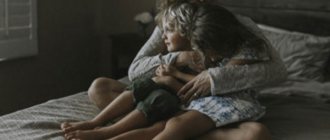You prefer to wait outside the door if a bug-eyed pug is grunting and munching in the apartment. Don't go shopping with a friend who never lets go of her Chihuahua and loves to cuddle. And under no circumstances would you agree to go to a dog shelter to make one of the still homeless dogs happy. Cinemaphobia leaves you no choice. You might think that being afraid of dogs only affects your life because there's no fur on your clothes and there's no Pedigree on the shelf, but in reality, this fear significantly limits your options. And getting rid of it is the only way to become the master of your life again.
Symptoms of cynophobia
The main symptom of cynophobia is constant internal tension in the patient without objective reasons.
He constantly seems to be expecting a dog attack, and is haunted by obsessive thoughts about a potential threat. Sleep disturbances are also a concomitant symptom of most anxiety-phobic disorders. Nightmarish dreams, insomnia at night and drowsiness during the day, interrupted sleep, a long time to fall asleep - a typical clinical picture with increased anxiety.
The film phobe often turns pale, blushes, and may feel hot or shuddering for no objective reason. The desire to constantly change body position, fussiness and languor, involuntary movements indicate akathisia. The following somatic symptoms are characteristic of a cynophobe:
- muscle spasms;
- increased sweating;
- cardiopalmus;
- tightness in the chest;
- heart pain, arrhythmia;
- strong thirst;
- increased diurination;
- disorders in the gastrointestinal tract.
Mental symptoms are no less diverse:
constant nervous tension; excessive caution; fixation of attention on negative phenomena; aggression, irritability; attempts to control your every action and thought; “soul-searching”, the desire to analyze the past; pessimism, obsessive thoughts about bad premonitions -
Here is an approximate description of the psychological state of a cinemaphobe.
In severe forms of the disease, panic attacks periodically occur. During an attack, the patient experiences uncontrollable horror of the object of the phobia, as well as the fear of death from a lack of understanding of what is happening to his body. All this is accompanied by extensive somatic symptoms, as well as depersonalization (loss of division of the world into “one’s own self” and “others”), unrealization (biased vision of what is happening). In addition to panic attacks, vegetative crises and situational nervous breakdowns may appear against the background of fear of dogs.
A kinophobe’s pronounced symptoms manifest themselves not only in the presence of dogs. Sometimes just the thought of fear, a bad feeling, or imaginary apprehension is enough to trigger an attack. In this case, the following physical symptoms are present:
- arrhythmia, tachycardia;
- asphyxia, feeling of suffocation;
- hyperhidrosis;
- pressing headaches;
- vomiting, nausea that does not bring relief;
- aggression towards others without objective reasons;
- intense anxiety;
- slurred speech, disordered thoughts;
- thoughts of suicide, fear of dying.
Causes of phobia
If a woman became afraid of dogs, or a man, then, most likely, this event was preceded by some external factors. In rare cases, this phobia may be congenital; in others, it is provoked by one of the following reasons.
- Misbehavior of parents. From childhood, a child may be prohibited from touching a dog, even a domestic one, with the argument that it might bite. Over time, the baby develops an understanding that dogs pose a danger to him.
- The grin of an animal can greatly frighten a child or a weak-willed man or woman.
- Experiencing an attack, either as a witness or as a victim, can even create a lifelong phobia.
- Fear of rabies. In fact, the fear is directed at the disease that these animals may carry.
- Being present at dog fights shows how aggressive these animals can be and what injuries they can cause. And this can give rise to severe fear when being close to a dog.
- Watching scary films in which dogs play the main roles.
To read: What kind of guys do girls like and why am I not one of them?
It is not always the case that a person who has survived a dog attack begins to experience strong fear towards these animals. My brother was bitten on the leg by a dog as a child, and quite severely. However, when he grew up, he did not dislike these animals and is not afraid of them.
Treatment of cynophobia
If the prerequisite for the phobia is an objective reason - psychological trauma from a dog bite, from an attack by a pack of animals, then psychotherapy is very effective in this case. There are many techniques specifically developed by psychologists to treat fear of dogs.
In the absence of timely treatment, cynophobia can cause antisocial behavior: a person “falls out” of social life, stops going out into the street, to work, and reduces communication with other people. Most often, it is not difficult to remove a phobia through working with a psychologist. But sometimes a course of psychotherapy is not enough to treat a phobic disorder in a severe stage. In this case, additional drug treatment is prescribed. Today, a course of SSRI antidepressants is considered the most effective.
In the presence of phobic disorders, the dog also suffers from somatic and mental symptoms, and in particular from sleep disorders and nightmares. So remember: the object of your phobia is afraid of a lot himself!
Diagnostic methods
Proper treatment of kynophobia requires an accurate diagnosis. The true type of fear is diagnosed according to the following criteria:
- patients avoid any situations that contribute to fear;
- primary symptoms of anxiety are observed;
- vegetative manifestations are noted;
- a feeling of anxiety appears in certain situations, when confronted with a specific object.
In cases where cynophobia is a symptom signaling the manifestation of another mental illness, the doctor selects appropriate therapy.
Getting rid of fear
If cynophobia arose as a result of psychological trauma due to an attack or a dog bite, then psychotherapy will be the most effective way to cope with fear. Without contacting a specialist, a phobia can provoke a person into reclusion. The film phobe will stop going out.
In addition to psychotherapy, in especially severe cases, the patient is prescribed a course of medications. Antidepressants from the group of selective serotonin reuptake inhibitors (SSRIs) have proven themselves well. Indications for their use include panic disorders, depression, and increased anxiety. But they can only be used as prescribed by a doctor!
For those who do not suffer from cynophobia, but are simply afraid of dogs, I would like to offer some advice from psychologists.
If you only have fear of a certain breed, then try to find someone you know who has such a puppy. Play with your baby, take a walk with him
Then you will understand that this is an ordinary child who needs love, care, attention and affection. If you often have to visit places where there are a lot of stray dogs, then buy yourself, for example, a stun gun. Possessing such a means of self-defense in itself already gives confidence and a sense of security. Start socializing with dogs of the breeds that cause you the least fear.
Ask the owner for permission to pet the dog, play with him, and treat him to something tasty.
You need to overcome fear gradually. Make yourself a step-by-step plan. Describe the situations and actions in it from the least frightening to the most panic-inducing. A sample plan might look like this.
- Look at photographs of dogs.
- Watch videos and films about them.
- Watch the dogs in the yard through a closed window.
- Look at walking dogs through an open window.
- Look at dogs on the street walking in a muzzle and on a leash.
- Be in the same room with the animal.
- Pet the dog.
Moving from point to point, you will gradually stop being afraid. You may even fall in love with these animals and want to get a pet yourself.
According to animal psychologists, some dogs are also susceptible to phobias. These include, for example:
- fear of loneliness and separation from the owner;
- fear of certain loud noises.
Many street dogs are afraid that people will hurt them. This fear arises because some people kick them, throw stones and sticks at them. Even aggressive dog barking, which scares us so much, is associated precisely with cruelty on the part of people. The dog senses danger from a person and tries to protect itself.
In general, the one you fear so much is himself afraid of a lot.
Adviсe
To make it easier to overcome your phobia, get a small puppy of a friendly breed
- To understand how not to be afraid of dogs, you need to understand the reason that led to the formation of this phobia. If nothing comes to mind, you need to mentally return to childhood. Remember when you first experienced this fear, understand what happened before it. If the reason really lies in childhood, then perhaps it’s time to rethink your fears, understand that you have grown and become stronger.
- If your dog's aggressive barking scares you, think about why it behaves this way. In most cases, this is a way to protect yourself when the dog senses danger from a person. Perhaps this particular animal was repeatedly abused by people.
- You can watch the behavior of the yard dogs from the window and make sure that they do not bother anyone unless they are hurt.
- To make it easier to make friends with man's four-legged friend, you can go to a place where dogs are often walked and chat with the owners. There you can hear many interesting stories from animal lovers. Over time, you will no longer be so scared to be near them, and then you will want to try to touch the animal, over time you will love it.
- If possible, try to get yourself a pet, a small puppy, for example, a Labrador or a shepherd.
- If you meet unfamiliar dogs on your way, there is no need to try to run away or freeze in place. In such a situation, you need to muster all your willpower, suppress your panic and continue going in the same direction. Most likely, the dog will remain silent or bark for show, but will not attack.
- If this happens and you live in an area where a large number of stray dogs constantly live, then it will not be superfluous to purchase a stun gun. Carrying such a device in your pocket will make you feel calmer and protected.
- If you still cannot overcome your fear, you can seek help from a specialist who can give you valuable advice.
Root cause
However, if the above situations did not find a place in your life, and the dog still experiences such phobias, it is worth thinking about the root causes. If a dog is afraid of a person, and not only of strangers, but also of its own owner, it means that it has a very susceptible and, at the same time, traumatized psyche. All fears that arise in an animal when it sees a person are divided into two categories.
- These are the ones that have a reason.
- And the reason for which, unfortunately, is impossible to see.
Let's look at the first category. If fear has its basis, it means that the animal received negative emotions, was in a dangerous situation or experienced pain. Most often, fear is a consequence of life experiences. Thus, dogs that once happened to be caught by dog handlers, experienced rough treatment and bullying, are rarely inclined to communicate with humans. Those people who have a similar structure to the torturers will remind the animal of what they have experienced.
The cause of fear of people may be a traumatized psyche
Fears that have no reason are often recorded by veterinarians. For example, an animal becomes afraid when a baby cries. Or he begins to be afraid of any family member for no reason, while the person has never done anything bad to the animal. If you can determine the cause of the phobia, it will be much easier for you to fight it.
The dog needs to be helped to overcome uncertainty, but in no case should it be supported. Sometimes animals are insecure due to the fact that they are weak in front of their relatives. This feeling of weakness carries over into the home, where the animal feels vulnerable in the presence of people.
Options for fear
- Fear of small dogs. At the same time, a person calmly treats healthy dogs, but he is stressed by small mongrels, from whom you don’t know what to expect. It is believed that the smaller the size, the more aggressive it can be. This happens because the small animal is afraid of everyone around her.
- Fear of decorative dogs. Cinemaphobes explain it by the fact that secret aggression may be hidden under the guise of a cute animal.
- Fear of large dogs. Most often observed. When any person sees a healthy dog, the instinct of self-preservation is triggered. People may even develop associations with sharks, crocodiles or piranhas.
- Fear of stray yard dogs. These animals found themselves in the wild and learned to survive. For them, aggressive behavior may become the norm.
- Fear of dogs on a chain. It is believed that animals that are deprived of their freedom become aggressive.
How to deal with a dog's tantrum on the street
If your pet is not yet used to walking, he may stop in the middle of the road, whine and resist. What should the owner do? It is generally not advisable to encourage cowardly behavior. In this case, this is acceptable. You must learn to balance: not to turn your pet into a hysterical person, but also not to leave him completely without support. You can calm it like a dog: gently squeeze the puppy between your legs to let him know that he is under protection. Babies can hide behind their mother like this. They feel warmth and reliable protection.
Sometimes it's wise to give it a break. Stop for two minutes and let your client get used to the new environment. Continue on your way and observe. If the attacks are repeated too often, it's time to stop. There is no need to walk until you are exhausted. It is acceptable to carry your pet home in your arms if you accidentally crossed the line.
Independent measures to combat cynophobia
How to get rid of the fear of dogs yourself:
- Review your diet. An incorrect menu leads to disruptions in the balance of carbohydrates, proteins, fats, vitamins and minerals, which provokes disruption of the functionality of the central nervous system and brain. Physiologically, this is expressed by anxiety. A diet for fear of dogs is aimed at increasing the number of carbohydrates in the diet. They secrete tryptophan, which is converted to serotonin.
- Normalize sleep and rest patterns. Mental fatigue is no less dangerous for the brain. You need to sleep 8–10 hours. If mental work predominates, then physical activity should be introduced in your free time. It is better to avoid delays at work and additional work at home.
- Workout. The type does not matter, it can be swimming, gymnastics, athletics or any other. Sports walking in the fresh air also helps eliminate anxiety and improve central nervous system activity.
- Find a hobby. Doing what you love improves your mood, self-esteem, and distracts you from bad thoughts.
- Take time for self-discovery. Daily training in this field can bring considerable results. Self-improvement and knowledge of your spiritual self allows you to find harmony of body, soul, mind, reveals hidden talents, and brings you closer to the world around you.
- Work on your consciousness. You need to try to imagine yourself as the owner of a dog. By gradually cultivating it in your imagination, you can raise a large and strong pet, but with good thoughts and morals.
- Find a weak point in the subconscious. In psychological practice, this exercise is called the “Achilles heel.” The principle of working on yourself is to compare associations in the presence of fear. That is, a person must explain what exactly he is afraid of when he sees a dog, and what he feels at that moment, what he wants, who in his mind can help solve the problem. Having understood these principles, a scenario is built for a meeting between a film-phobe and a loved one with an animal. Moreover, in this case, the four-legged one experiences fear, and the “guard” present in the thoughts provides support and protection to the client. Sometimes long training is required before a person can overcome his problem. If you concentrate on your own fear of dogs, then stop the exercise and repeat it at another time.
A phobia of dogs is expressed in a vivid panic fear of a pet. Cinemaphobes avoid not only animals themselves, but also all possible reminders and associations with them. You can overcome fear on your own by changing the principle of life, diet, and playing sports. In case of advanced pathology, a psychologist-hypnologist will help with this. If you ignore the problem, it will unbearably infringe on the person and lead to his isolation from society.
Adaptation for a Shy Puppy
It's good if you noticed the problem in time. Cowardly dogs are incredibly difficult to train
They may be smart, but fear is stronger. When training pets with a weak nervous system, “kickbacks” often occur. Just yesterday the puppy was calmly walking on the street, and after meeting a cyclist he is afraid to leave the house? Typical situation. Be patient.
What should be done? Adaptation program for a shy puppy
1. Take a walk.
Take a long walk at least 2-3 times a week. Yes, the baby will panic a lot, but it is necessary. In the process of walking, the puppy will get used to the street, and you will establish a close bond. Focus not on physical activity, but on studying the world around you. Walk along the streets, parks, bus stops... Always praise and give a treat for showing curiosity. This way, you will reinforce the normal reaction.
2. Be friends.
It is important to get to know the owners of adult, well-trained dogs. The younger ones follow the example of the older ones
It will be much easier for the puppy if he has company.
3. Train.
Cowardly pets need to be given mental exercise. During training, the animal concentrates, is distracted and calms down. This will provide better control in the future and help prevent scares.
These are the main, but far from the only points. Pay more attention to your relationship with your dog. Try to make her more confident, stroke and caress her more often. Make your pet feel like part of the family. Don't shout or scold.
Don't expect instant results. The effect will accumulate gradually. Most often, the program takes 6–12 months. Be prepared for the fact that you will have to struggle with certain problems throughout your life.
What actions are unacceptable for a parent in such a situation?
First of all, parents should highlight for themselves those points that are unacceptable if their children have cynophobia:
- You cannot joke with a child, tell him that his fear is stupid or ridiculous. This also applies to ignoring the problem. Not paying attention to the baby's fear, the adult only aggravates his emotional state.
- You cannot appeal with words like “don’t be afraid,” “be brave.” Firstly, such expressions will not give any result. Secondly, they will negatively affect the child’s psychological perception of himself and cause insecurity and complexes.
- Negative statements about dogs and their owners are unacceptable, since the child will repeat this behavioral model, continuing to experience fear of animals.
- You cannot react negatively to a child’s fear. Irritation or aggression towards the baby will only increase fear. It would be more correct to calmly switch the child’s attention to something else.
There are not many prohibitive rules, but they must be strictly observed. In addition, the parent must remember one more point - one should not try to shape the process of dealing with a phobia. That is, attempts to quickly introduce a child to a dog, or a violent collision between a child and an animal are strictly prohibited. This must not be forgotten not only because such actions will interfere with the fight against cynophobia, but also because due to an inadequate reaction of the child, the animal may become nervous and the situation will become dangerous.
The only way to avoid trouble is to not make a mistake when choosing a puppy.
Chat with the breeder. If he has nothing to hide, he will kindly answer all your questions, show his parents and conditions. Defects of the nervous system are transmitted genetically, so observe the behavior of the mother of the puppies.
One way to test temperament is through tests.
- Check your babies' reaction to noise. For example, the sound of keys falling. The “correct” puppy may be scared, but he will quickly adapt and go to see what is lying there.
- Try taking the baby to another room or outside if you have a fenced yard. See how he will behave without his brothers, sisters and mother. Bring a toy or some object. Observe the reaction.
- The baby should not bark, hide or just sit. A normal puppy is friendly and moderately curious. Of course, everyone is individual, but some reactions go beyond the norm.
Many choose the most timid and unfortunate one, because it becomes pitiful. Are you absolutely sure that you can cope with such a test? If yes, then let's find out what to prepare for.
Socializing a pet that is afraid of people
How to deal with a fearful dog:
- Remember that during times of fear you should not feel sorry for your pet, nor should you scold it. He becomes disoriented and will continue to be afraid next time, in the hope that he will be pitied.
- You are a strong master leader and remain calm. Pretend that you are not afraid of anything, let the dog take an example from you.
- Socialize your dog gradually. First, meet new people.
New acquaintances can come to visit you at home or invite old friends for walks
At the same time, do not focus on your pet. Don’t let him start to be a coward ostentatiously and think that this is necessary, since there are guests in the house or an old acquaintance is with you on a walk.
When the dog gets used to a person, you can ask him to talk to him affectionately, and then bring your hand to his muzzle (hold your palm up), let him sniff and carefully try to stroke him. Gradually begin to communicate with other people, then walk the dog on a leash in the company of its old friends
If you adopted a dog from a shelter, which is noble, but he is very shy, then even a year may not be enough for him to get used to it and begin to trust people.
A good way of socialization when you take a puppy into a home where there is an older dog. On the street you, and then an acquaintance of the older dog, pet him. The younger one will observe that he likes it and sooner or later he will allow himself to be stroked. The main thing is that the dog is among people every day. Isolation will lead to even greater fear of a person.
Every day 2-4 times or even more, take your pet for walks among people. Start walking in less crowded areas and gradually move to busier ones. As the fruit of your long psychological work on behavior correction, you will soon be able to walk with him even around the market, examining and choosing goods.
When your pet gets comfortable in a city or village, even take him to exhibitions, even if only as a guest. There he will see many relatives.
What absolutely should not be done
There are many ways to raise a hysterical, cowardly and potentially dangerous dog. In addition to outright cruelty and boundless indifference, the following can lead to this:
- Shouting, insults and physical abuse in various situations. It doesn’t matter whether the pet misbehaved, didn’t follow a command, or the owner is simply in a bad mood. You cannot take out anger and irritation on an animal, and screaming has never been the right method of education.
- Limiting your pet's communication with other animals. If isolated, the dog will perceive both a huge St. Bernard and a tiny duckling as a threat. The result is a desperate coward with a shattered nervous system.
- Lack of training and regular walks. The dog must receive new information. In addition, it is natural for her to relieve herself in nature, and not in a tray or on a diaper. Isolation has never made anyone brave.
- Prohibition for pets to communicate with pets. In this case, he will perceive everyone as strangers. Of course, dogs of guard breeds should not fawn over strangers on the street, but friendliness will not harm decorative dogs at all. In addition, they will not perceive people as a threat.
- Reluctance to visit a veterinary clinic and grooming salon. This is also a type of communication when a dog finds itself in an extreme situation. Soon she gets used to it and is no longer afraid. For her, a visit to the doctor or a wash, haircut, or nail trimming cease to be stress triggers, so they do not provoke the appearance of fear. If the dog is completely unprepared for such a situation, then his reaction can be unpredictable, which will have a bad effect on the state of the nervous system.
To adapt an animal to everyday life, you need to communicate with it, and not shake it like a porcelain doll. Such treatment can do him a disservice.
What is the fear of dogs called?
What is the correct name for fear of dogs? This concept comes from the Greek κυν - dog and φόβος - fear. Cynophobia is characterized by an inexplicable, uncontrollable fear of dogs.
This pathology has subtypes:
- adactophobia - fear of being bitten;
- Rabiephobia - fear of contracting rabies.
The fear of dogs appears not only in close proximity or contact with an animal, but also when watching films, pictures, videos with it. On average, there are 1.5–3.5% of film phobes worldwide. For the most part, this figure consists of children and young people under 30 years of age.
If the pathology is not treated in a timely manner, then the phobia of fear of dogs progresses. Cynophobia is often observed in hypochondria, senestopathy, and schizophrenia. The risk of getting sick increases with significant overstrain of the nervous system, neuroses, depression, and breakdowns.
Main manifestations
- Feeling of pseudo-threat. In a situation where a person’s life is not in danger, he may experience uncontrollable fear, even at the sight of a small puppy.
- Bodily discomfort. Chest pain, chest tightness, and muscle tension may occur. Moreover, even the barking of a dog that is at a distance can provoke a panic attack.
- Fear even of pictures of dogs.
- Psychopathological condition. Characterized by alertness and increased irritability. A person is afraid to even go out into the yard, because there you can meet stray dogs.
How to behave when meeting a dog
To understand a dog’s mood, you need to study its habits. By the behavior of an animal, you can determine what is “on his mind.”
| Dog behavior | Mood |
| Walks from side to side. The tail is tense. | He thinks whether to attack a person who is in his field of vision or not. |
| Joyfully swings its tail and sticks out its tongue. | Wants to play or get acquainted. The animal is friendly. |
| She pricked up her ears. The fur stands on end. | Shows dissatisfaction and prepares to attack. |
| She tucked her tail and flattened her ears. | The animal is afraid, but is still ready to attack to protect itself. |
| Roars, showing his fangs. | A sign of immediate readiness to attack. |
| Barks loudly. | Defends its territory. He warns that he will bite a person if he does not leave. |
Basically, dogs only attack if provoked. Although there are exceptions to the rule. Dog handlers do not recommend doing the following when meeting a stray dog:
- wave your arms;
- shout loudly;
- throw stones or sticks at the dog;
- look the animal straight in the eye.
Such human behavior will only cause aggression in the beast. Here's what to do if you encounter a stray dog or a whole pack of unfriendly animals on your way.
- Try to pass by as calmly as possible. Dogs are great at sensing someone else's fear and are great at recognizing false confidence.
- Lower your eyes down and press your hands to your body. So, the dog will see that the person is not dangerous.
- Don't smile. Your smile may be perceived as a grin. And this is already a signal to action: we need to defend ourselves.
- Don't run away. This makes absolutely no sense if you cannot quickly hide in an entrance or other room. The animal is almost always faster and more resilient.
- Don't turn your back on them. They will definitely attack from behind.
- In a pack of dogs, always look for the leader. If you can scare him away, get rid of everyone else.
- Try to distract a dog that is about to attack. To do this, throw her some, preferably edible, object. The animal will switch to him and forget about the person.
Dogs guarding private homes feel at home in their territory. They are the protectors of the house and its inhabitants. Therefore, the animal will definitely bark or growl at a stranger passing by. Take her barking as a kind of alarm. Calmly pass by, observing the animal with peripheral vision.
If the animal is not on a chain and rushes after you, then stop and turn to face it. Try to remain calm. Although, of course, in such a situation it is very difficult. Most likely, the dog will simply sniff you and return to his booth. You can give him the command: “Ugh!” Just do it in a confident and firm voice. Almost all pets understand this command.
For inner peace, carry one of the following self-defense means with you:
- stun gun;
- gas cartridge;
- ultrasonic dog repeller.
They will help protect yourself in case of an animal attack. If suddenly the dog attacks you, and there are no devices at hand, then hit him in the nose. This neutralizes the beast. A dog's nose is the most vulnerable spot.
A dog is a pack animal. She senses hierarchy and submissively submits to the one who is higher in this hierarchy. And at the top it is always the most confident - the leader of the pack. A little earlier I wrote that if you are afraid of dogs, then do not look them in the eyes. Otherwise they will take it as a signal to attack.
However, if you are a person who does not allow doubts about his superiority, then your direct gaze into the eyes of the animal will make him obey. The dog will lower his eyes and begin to whine. So cultivate confidence in yourself, and no dog will be afraid of you.
Correction of cowardly behavior in dogs and puppies or how to stop being afraid of people.
Animal psychology Answers from dog handlers to the question: how to wean a dog from being afraid of people? Raising Mickey is a dog who hides under the bed whenever someone comes into the house. Chala barks and squirms under her owners' feet if a child approaches. When a man approaches Josie, she involuntarily urinates. What do all these dogs have in common? Dogs are afraid of certain people: strangers, children or men. Pay attention to whether your dog tries to find a secluded place and hide if people come into the house. This may mean that the animal is feeling uncomfortable! Dogs that are afraid of people are usually described as shy, fearful, nervous or wary. Shy or fearful behavior is easy to recognize: dogs run, hide, or tremble when they see a stranger approaching them. But fear can manifest itself in a wide variety of behavioral patterns. In response to fear, reactions may appear that foreign trainers call the four Fs:
stupor (freeze),
fight,
flight
and fooling around.
Jumping, attention seeking, urination, panting, drooling, excessive shedding, and lack of eye-to-eye contact may also indicate uncertainty or fear. Growling, barking and other aggressive actions can also be based on fear.
Where does embarrassment come from?
Cowardly animals are found among dogs of any size, weight category and breed. Why are dogs afraid? The popular belief that dogs that are afraid of people have at one time suffered from mistreatment or experienced something terrible is sometimes not entirely true.
Sometimes this is true, but genetic predisposition and lack of communication (socialization) in puppyhood tend to have a greater influence. Owners of shy dogs can rarely name the exact reason. Fortunately, you don't need to know the reasons to help your animal overcome its fears. Scary people are everywhere. The first step in helping your dog overcome shyness is to identify exactly who he is shy about. Sometimes it seems that a dog that is shy or afraid is afraid of everything around it. But by thinking carefully and determining exactly who she was afraid of and under what circumstances, you can get very useful information. This will help you in compiling a list of people your dog is afraid of. For each shy animal such a list will be unique.
One dog I know has a list like this that includes all strangers outside the house. For another dog, these are children who are under five years old. The more accurately you understand what scares your pet, the better. Once you have figured out who or what is causing the fear, you can begin to take steps to calm down your reaction to scary things and make it calmer. Situation management will be your best friend in the early stages of working with shy dogs. How situation management works. Roughly speaking, managing the situation involves moving away from the problem or what is causing the problem (in this case, scary people) while surrounded by the dog. Management alone will not solve the issue of fears, but it can prevent the dog from reacting, such as cowering, urinating, barking or growling, until the animal becomes more comfortable around those it fears.
Managing the situation can reduce stress levels for the pet and its owner, and create an environment conducive to training and behavior modification. In some cases, management plays a major role in the matter of safety (note that if a dog bites someone, even in a fit of fear, a dog handler or other certified animal behaviorist should be consulted).
Each animal has a different control strategy depending on what causes fear. For example, if you are the owner of a puppy who is afraid of strangers, you may find the following strategy helpful:
• Avoid crowded areas where your dog is surrounded by strangers.
• Use an aviary or a children's fence or compartment to prevent interaction between the dog and strangers in your home.
Also think about how to protect your dog from sudden attacks:
• If a stranger comes up to you and asks you to pet your dog, answer: “No, I'm sorry, but it makes my dog uncomfortable.”
• Place yourself between the person and the dog.
• Create distance by crossing the road or heading in the other direction.
Once you have mastered the management of the situation and your dog's stress level has decreased, get ready to train, work on desensitization, and master the “contradiction method”!
Workouts for confidence.
Simple training sessions are fun and also help make your pet more confident.
Teaching your dog simple commands such as “sit,” “down,” and “place” will lay a good foundation and teach your dog to always look at you when he is in doubt.
In addition, rigorous training such as rallying, musical freestyle or agility can greatly improve a dog's self-confidence. While all training will help when working with fearful dogs, these three exercises will be most effective in increasing your dog's self-confidence: • Ask for everything politely. Make sure your dog sits or lies down before petting him, feeding him, playing with him, opening the door for him, etc. This builds a mechanism that relieves stress in dogs and also teaches the dog to expect instructions and rewards from you.
• Remember the reward. Recognize any instances of good behavior in public with rewards. For example, if you are “out” and your dog sits in front of strangers, acknowledge the behavior with a gesture or word (such as “yes!”) and give your dog a reward. If your pet interacts politely with a friendly child, acknowledge the behavior (with a gesture or word) and reward the dog. Reward your dog for behavior, even if you didn't ask him to do it! With the help of rewards during correct actions, the dog remembers the behavior and tries to copy it in the future, reducing its stress level.
• Practice standard behavior. Standard behavior (this is a behavior when the animal does not know what else to do) can be a good help for a nervous dog. An excellent example of this standard for dogs is the command: “At me!”, which means: “Look at me, in my eyes.” This helps your shy pet get oriented and also take his mind off people who scare him. They got too close to the dog! The shy dog freezes in fear and looks away. Now he needs to be as far away from the stranger as possible. Additionally, you can use the presence of “scary” people for commands and behavior training. When the dog has already become accustomed to the “come at me” command, begin practicing it among strangers or other people who frighten the pet.
While working, stand at a safe enough distance from the dog so that it stops worrying about the close presence of other people.
Every time a scary person appears on the horizon, say a command and reward the dog for performing it correctly. When your dog sees a scary person and acts as you ask, immediately reward the dog with 10 treats and shower him with praise.
Shifting Emotions And while appropriate behavior training works to promote confidence and teach a dog how to behave appropriately around people who might frighten him, desensitization and the “contradiction technique” can be key tools to help a dog overcome fear.
If you've ever dealt with fears, say, a fear of heights or a fear of spiders, you know that using logic is not always enough to get rid of this fear.
You can't just say, "Hmm, it's stupid to be afraid of spiders, so I won't be afraid of them anymore." Moreover, any mention of “scary” makes your palms sweat and your heart beat faster. When a dog gets scared, it experiences something similar, both emotionally and physically.
Desensitization and the "contradiction method" always work well in helping the dog overcome the emotional and physical sensations that result from fear of people.
Desensitization involves confronting those things that cause fear (for example, strangers) at an acceptable level (at such a distance that the dog notices them, but does not lose heart). The “contradiction method” involves presenting a pleasant stimulus (for example, a piece of “yummy”) in the presence of a frightening thing (a stranger). The goal of this method is to change the emotional and physiological response to a stranger from fear to pleasure and relaxation.
Let's Get Started Here's what desensitizing and "contradiction" tactics look like for a dog who is afraid of strangers: • Determine what scares your dog - the more specific the better!
• Choose something special to fix the situation. This is the time when you should use the most wonderful thing your pet can imagine! For many dogs, the best option is meat: roast beef, hot dogs, chicken breasts. For some dogs, there is an alternative in the form of a particularly valuable item or game (I know a dog who quickly lost his fear of children when the neighbor kids started playing ball with him). Make sure the dog is motivated - if you use food as a reward, the dog must be hungry!
• Determine the acceptable level for the dog. See how close the stranger is, how many people are nearby, and what they are doing. For example, a dog is not particularly nervous in the presence of one or two people at a distance of 10 meters.
• Ask someone to play along with you and come within 10 meters. Every time the person appears and your pet notices him, start rewarding the dog with tidbits. Give a new piece as soon as the dog swallows the previous one.
• When the person moves to a safe distance, stop feeding the pet.
• Repeat the exercise until the dog waits anxiously and glances at you in anticipation of reward every time a stranger appears in sight.
• Once your dog has become comfortable with the stranger, ask the person to move a little closer, perhaps a meter.
• Repeat the procedure (several times over several days), each time asking the stranger to come as close as the dog is comfortable. Animals that are not particularly shy will only need a few visits so that a stranger can calmly walk near the animal, and the dog is happy to see him. Animals with more intense fears will require training with different people over a period of months.
Please be patient! Effective desensitization and the “contradiction method” are like watching paint dry (unless you are a trainer and genuinely enjoy such things). Remember that you need to work at an acceptable level. The process is slow and laborious, but the game is worth the candle.
Favorable Opportunities In an ideal world, the “contradiction method” is used in conjunction with desensitization (that is, the dog is introduced to people who frighten it at an acceptable level, when the animal is relaxed and feels comfortable). However, in the real world, while you are working with fears, it is impossible to get your pet to ignore people who scare him. This is fine.
Practice the “contradiction method” (feeding treats) every time you see a scary person at a distance that makes your dog anxious.
In fact, owners of very timid dogs can introduce this feeding practice into their daily routine. Feed your pet whenever you are walking and see a stranger.
If a stranger comes into the house, feed the dog in his presence. If your dog feels comfortable, you can even ask a stranger to give your pet treats.
If you ask other people to feed your dog, ensure their safety by giving appropriate instructions: • Ask a helper to wait until the dog approaches; There is no need to approach the dog yourself. • Try to arrange for the helper to stand or sit to the side of the dog. Ask him not to lean towards the animal or make eye contact with it. Take every chance to get a positive impression from strangers; Remember dogs love treats! • The helper should hold the treat in his open palm and wait for the dog to approach and take the food from his hand. If the dog is too scared to approach, the helper should gently lower the treats to the ground.
• Attention! A fearful dog may temporarily overcome its fear in the presence of a very tasty morsel, but then bite the feared person when the bait is no longer available. Do not ask strangers and helpers to feed treats until you are sure that sensitivity has been sufficiently reduced - the animal should no longer be afraid of approaching strangers or be frightened by the appearance of strangers. Praise your pet when he or she shows confidence and spends quality time with other people. Your Dog Sets the Pace One of the most important things to do with your shy dog is to respect his fears by allowing your pet to set the pace at which he gets used to new or scary people.
Prevent his mistakes in behavior by properly managing the situation.
Teach your dog basic habits so that he knows what to do in new situations.
Be generous with large doses of treats in the presence of scary people so that your pet can overcome his fears. I have seen dogs that were shy but not very fearful become more confident in a couple of short weeks. But I have also seen dogs that took up to two years to feel more comfortable.
No matter how long it takes, the time and investment will be worth it - both for you and especially for your pet! Helping you gain confidence and overcome fears is not only one of the greatest gifts you can give your pet, it is also a very rewarding experience! Author: Mardi Richmond, translated from English.
How to help your child stop being afraid
Young children are very impressionable. The reasons why a child begins to be afraid of dogs may be:
- a dog attacking a child;
- dog bite;
- sharp and loud barking;
- large sizes, especially when the dog is larger than a child;
- grin and angry growl;
- an animal attack on other people, which occurred in front of the baby.
Parents need to behave correctly to prevent the phobia from developing even stronger. You cannot do the following:
- calling a child a coward;
- make fun of his fear;
- criticize;
- force the child to face his fear.
Here are some tips to help your child overcome fear.
- When passing a dog on the street, hold your baby's hand tightly. He will feel safe under your protection.
- Watch movies and cartoons with your child in which dogs are depicted as friendly animals.
- Go with your child to visit where there is a puppy. Let the baby play with the dog.
- When telling your child about dogs, do not focus on the fact that she can bite. Better describe the positive qualities of the animal.
Be sure to teach your child how to behave correctly when meeting dogs, namely:
- do not touch her when she is eating or licking puppies;
- do not run away from dogs;
- do not look the dog directly in the eyes;
- do not approach stray animals.
How to deal with cynophobia
Once the cause of the phobia has been identified, you can begin to work on it. To achieve the desired outcome, namely, a calm or even positive reaction of the child to dogs, it is necessary:
- Read and tell various stories or fairy tales in which there are dogs as assistants or some positive characters.
- Include cartoons and films with dogs, and after watching, discuss the characters and emphasize that these animals are very good.
- For children who love to draw, it is a good idea to try to depict kind dogs in different situations.
- Give your child a toy in the shape of a dog, soft and cute, but similar to the real one, in order to form an association between the artificial and the living pet.
- Arrange games in which you need to portray animals. In the first games, the parent should portray the dog, showing the character and behavior of the animal. And then you can invite your child to try to pretend to be a dog himself.
- Observe the animals from the outside. You should start by watching programs and videos about dogs that will be shown in funny situations or during the training process. Later, you can invite your child to look at the animals in the park, but do not come close so that the child does not get scared.
- Communication with animals in a safe environment. It is worth asking someone you know with a dog to come visit so that the child can interact with the animal in person and make sure that it does not pose a threat to him. It will be best if the owner of a small or medium-sized dog comes for the first time, since adaptation to them will be easier. Then you can invite someone with a large pet.
These points should be carried out gradually, moving from the first to the second with constant monitoring of the child’s reaction to four-legged animals. And we must not forget to constantly praise the baby and support him. Changing his view of dogs will directly depend on how much parents can provide him with psychological comfort while fighting a phobia.
The last step in the process of ridding a child of his fear of dogs can be purchasing a pet for the home. If your baby can already communicate with other people's dogs and reacts calmly to them, you can offer him to take home a puppy. This will help consolidate the result and become a good experience for the child.
Do not forget that there are situations when work with a phobia stops at some stage and parents cannot help the child overcome fear. In this case, it is better not to put pressure on him and visit a child psychologist so that he can take a professional look at the problem and give his recommendations.
When should you visit the vet?
Unfortunately, sometimes the reason for such animal behavior is not the lack of proper education from the owner. Weakness of the nervous system is a common reason why an animal cannot normally enjoy walks. Due to the fact that the nerve endings do not function properly, even adults behave differently, constantly on guard.
Such animals have a high risk of stroke and other diseases that lead to death. They may be frightened by rustling noises, a crying child, or sounds that are somewhat louder than normal. The main reasons that you should visit a veterinarian are involuntary urination during loud noises, fear and shaking if the owner raises his voice a little, and panicky fear of other people. The veterinarian must examine the animal and take tests if necessary. If it is determined that the dog has a weakness of the nervous system, and possibly other diseases, appropriate treatment will be prescribed.
Weakness of the nervous system is one of the reasons for a dog’s inadequate reaction to people.
If a dog generally feels bad, it considers itself vulnerable and snaps at absolutely all strangers from whom it can receive a threat. For example, animals that suffer:
- diseases of the gastrointestinal system;
- hearts;
- feels weak;
- elevated temperature;
- dizziness and pain;
- become an easy target, and realizing this, they try to protect themselves.
Therefore, before learning commands with animals and trying to socialize him in any way, be sure to make sure that nothing bothers the dog.
What do experts in the field of child psychology advise?
Psychologists give a number of recommendations for those parents who are trying to solve the problem of cynophobia in their children:
- When explaining a situation or an incident with an animal, you need to give the most understandable and accurate arguments for the baby.
- During conversations, it is also necessary to teach the correct actions in certain conditions. For example, if a child has a ball in his hands, and the dog wants it, you just need to throw the toy aside and the dog will run away. Also, you should not wave your arms or shout at the animal if it is unfriendly or just suddenly came close, and if there is a guard dog in the house or yard in front of the house, you must call the owners and only enter under their control.
- It is imperative to talk about dogs - helping people, acting as rescuers, bloodhounds, guide dogs, and so on.
- If the child is old enough, you can take him to a site where professionals train dogs or to a corresponding exhibition. This will be useful for general educational purposes and will show the child that dogs are not as scary as they seem.
What is cynophobia and why does it occur?
Cynophobia is an irrational fear of dogs that cannot be explained logically (like other phobias). This is not that uncommon: 1.5 - 3.5% of the population is terrified of dogs, and as a rule these are young people (under 30 years of age). Within the framework of cynophobia, a distinction is made between the fear of being bitten and the fear of contracting rabies.
It is worth distinguishing between true cinemaphobia and pseudophobia. The latter occurs quite often. Pseudo-fear of dogs is often characteristic of psychopaths (including sadists), who use fear of dogs as a reason to harm them or their owners. For example, a significant part of the so-called “dog hunters” belongs to this category. And knacker tendencies are covered up by illness.
Representatives of Islam who consider dogs “unclean animals” and avoid them also cannot be called suffering from cynophobia.
Cynophobia may be part of another mental disorder (such as schizophrenia).
As a rule, real cynophobia does not include aggression towards animals and their owners - such people only strive to avoid contact with dogs as much as possible. If you are dealing with a psychopath hiding behind pseudo-kinophobia, then manifestations of aggression on his part are possible.
Photo: google
Cynophobia is diagnosed if the following criteria are met:
- Manifestations of pathological fear that are primary and not caused by delusions or obsessive thoughts.
- Anxiety occurs only in the presence of dogs and in situations associated with them.
- The patient avoids dogs and everything connected with them.
- No other psychopathological disorders.
As a rule, panic fear of dogs arises in childhood and, without adequate help, can persist into adulthood. But, contrary to popular belief, dog attacks are extremely rarely the cause of this disorder. I have already written about how fear of dogs develops in children and whether it is possible to help a child cope with it, so I will not dwell on this in detail in this article.
Manifestations of cynophobia
Recognizing cynophobia is actually quite easy. To do this, you need to start listening to yourself more carefully. As a rule, a person himself is aware of its presence and tries to take some steps to get rid of fear. The fact is that such fear greatly complicates life and creates many obstacles that prevent an individual from feeling truly happy. A person often withdraws into himself, begins to avoid others, and avoids the possibility of even a chance meeting with a dog. As a result, it turns out that a person is often left alone with a problem and does not know how to cope with it. Let's take a closer look at the signs of cynophobia. What are they?
Feeling worse
Constant stress certainly has a negative impact on the human body. At some point, physical health begins to suffer. A person may begin to feel a deterioration in well-being precisely because he is under constant psychological stress. To bring yourself into a state of harmony, you need to start purposefully working on yourself. Constantly living with fear of dogs provokes the development of numerous ailments: from mild colds to serious damage to internal organs. Most often, people drive themselves into strong experiences because they do not understand what is really happening to them. Very often, an individual tries not to notice the problem until the last moment, so as not to take responsibility for eliminating the unpleasant situation. It is much easier to blame others than to try to solve the existing difficulty, because this will require a significant change in behavior.
Obsessive states
With developed cynophobia, a person is haunted by obsessive states. It happens that he develops fears associated with the appearance of animals. Such an individual generally tries not to keep any animals in the apartment, because he associates them with something unpleasant, certain painful conditions. A person may be haunted by fears, which are especially pronounced at night. Obsessive states often cannot be overcome by willpower alone. They capture the consciousness of the individual and force him to live as carefully as possible, without adventures or new discoveries. As a rule, a person is afraid to let something new into his life because he fears the possible consequences.
Fear of encountering horror
In a situation of developed cynophobia, there is a fear of experiencing fear. A person becomes so fixated on his feelings that he stops noticing the surrounding reality. Sometimes it seems to him that only bad things await him ahead. He sees unpleasant consequences for himself in any actions. The individual is not ready to devote enough time and attention to considering his internal state. A personality stops developing because it constantly runs away from an unsatisfactory reality and looks for easy ways. Each approaching dog is associated with horror, which the individual tries to avoid by all means available to him. When someone tells him that there is really nothing to be afraid of, the person gets angry and begins to think that they simply do not want to understand him. He can show aggression and speak extremely negatively.
Waiting for an attack
Meeting an unfamiliar dog on the street can turn into real hysteria for a cinephobe. In most cases, he will try to run away from the dog, to be safe as soon as possible. Moreover, this often happens instinctively, there is no understanding of the ineffectiveness of the chosen method. Sometimes a person freezes in one place and waits for terrible consequences for himself. Anticipation of an attack is an anxious feeling that haunts you. An individual can bring himself to the most unpleasant consequences if he constantly scrolls negative thoughts in his head. If you constantly expect something bad, you can inadvertently attract it to yourself. A person suffering from cynophobia often does not realize that he himself is ruining his life. He is so immersed in imaginary fears that he cannot realize how much he limits himself, trying to minimize the risks of a possible “catastrophe.” To many, it seems absolutely unrealistic to prevent the threat posed by an animal.
Aggressive behavior
In some cases, people suffering from cynophobia experience uncontrollable attacks of aggression. The fact is that subconsciously they want to protect themselves from their own fear, because in many ways it interferes with their lives. It becomes impossible to make responsible decisions, or to influence your destiny in any way. Aggressive behavior often becomes an action that allows you to cope with your own negative emotions. Overcoming unpleasant impressions sometimes seems like a very difficult action. It may take a long time to free yourself from the oppressive feeling of hopelessness. But the effort is definitely worth it.
Aggressive response to fear
Impulsive natures, choleric people, sanguine people do not run away when a feeling of fear appears. On the contrary, they immediately rush to an object that evokes negative emotions. If a dog not only barks at strangers, but also uses its teeth, it will not be possible to cope with such a pathology without a dog handler. Professionals know how to correct the behavior of such dogs.
If the pet barks, growls, but does not take active actions, you need to calmly and confidently approach him, take him by the collar and lightly pull him, give the command “quiet”. If this measure does not have the desired effect, you should squeeze the dog’s sternum with your knees and hold it until the object that caused the dog’s aggression leaves. Then you need to sit him down, sternly but calmly say “ok”.
You cannot pet or praise your pet when it is aggressive. If such inappropriate behavior appears, it is necessary to begin intensive socialization. Regular walks will be an important point. Gradually, you need to change walking areas from deserted ones to areas with active traffic, so that the dog gets used to it and understands that strangers do not pose a danger to it. A prerequisite is a friendly attitude towards the pet, calm, confident behavior in all situations.
Dog-human interaction
It is not a dog's nature to be afraid of people. Thousands of years have passed since the domestication of the beast by man. Dogs are faithful companions in hunting, recreation, long trips and in life. Today there are special animals that help sick people, so-called guide dogs or animals that distract from stressful situations.
For a dog, interaction with a person is also of great importance. Firstly, an animal that has its patron in the form of a person is self-confident, not subject to stress and anxiety, and easily socializes among its relatives. In addition, close interaction with people provides the basis for the development of the animal’s mental abilities. The dog takes actions in order to express its emotions, desires and feelings to the person. For example, at the moment of a strong impulse of tenderness and love, he begins to lick the owner, when he wants to eat, takes the desired position, and when the phrase “let's go for a walk” he waits at the door. An animal that has a close connection with people is highly trainable and responds to a huge number of commands without any problems. And animals that get along with people live longer. This is shown by various sociological studies.
Dogs are faithful companions to humans











